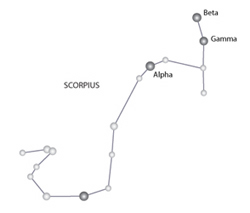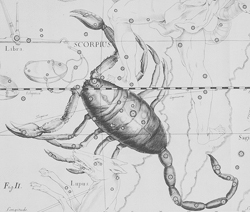Location: Visible between latitudes 40 and -90 degrees
Coordinates:
Right Ascension: 17h
Declination: -40º
 The story behind the name: Scorpius is one of the 12 constellations included in the Zodiac. Considered to be among the oldest constellations recognized by human civilizations, these 12 patterns were of particular significance to ancient cultures like the Babylonians because, as the Babylonian astronomers noticed, they mark the path through which our Sun, moon and planets appear to travel through the course of a year. The stars of Scorpius trace out the spine of the Scorpion (or of a dragon, according to Chinese legend), making it perhaps the most faithfully rendered constellation in the sky.
The story behind the name: Scorpius is one of the 12 constellations included in the Zodiac. Considered to be among the oldest constellations recognized by human civilizations, these 12 patterns were of particular significance to ancient cultures like the Babylonians because, as the Babylonian astronomers noticed, they mark the path through which our Sun, moon and planets appear to travel through the course of a year. The stars of Scorpius trace out the spine of the Scorpion (or of a dragon, according to Chinese legend), making it perhaps the most faithfully rendered constellation in the sky.
Scorpius rears his head (or, more accurately, his tail) in a number of different legends, the most popular of which involves the great hunter Orion. It is said that Orion, the gigantic son of Poseidon and Eurayle, claimed he could kill all of the wild animals of the world if he so desired. The goddess Gaia, protector of Earth and all its creatures, became alarmed by Orion's boast. Fearing he might one day act on it, she sent a scorpion to kill Orion. The rest of the legend then splits into various story lines. In one, the oversized Scorpion managed to sting Orion on the heel (marked by the blue star Rigel), after a great battle. Gaia then took pity on Orion and placed him in the sky as a constellation, setting the Scorpion at the opposite end of the heavens so that they could never battle again. Scorpius rises just as Orion sets, and in this, some see Orion forever fleeing its fatal sting. In another, the Scorpion was sent to kill Orion and, due to its small size and great stealth, managed to sting him quickly and kill him. In both of these stories, it is said that the great healer Asclepius ground the scorpion under his foot and then brought Orion back to life using herbal healing methods he had learned from observing a snake revive its brother. Hades, the god of the underworld, alarmed by Asclepius's ability to raise the dead, persuaded his brother Zeus to kill Asclepius. After doing so however, Zeus, regretting his decision, gave Asclepius the name Ophiuchus, or "serpent bearer", and placed him in the Serpens constellation, in recognition of his contributions to healing and medicine. The Scorpius constellation is located directly beneath Ophiuchus and the Serpens in the sky, just as the scorpion was killed beneath Asclepius's foot.
A variant story line has Orion fighting a great battle with the Scorpion and escaping into the raging sea. Orion had been given the gift of wading through oceans as if they were shallow ponds, and thus he strode away from the Scorpion who could not follow. Unfortunately for Orion, this gave the god Apollo, who was unhappy that his sister Artemis had fallen in love with Orion, the chance he had been waiting for. Apollo saw Orion enter the sea from a great distance and, calling to his sister, taunted her by saying she could not hit the distant black speck with one of her arrows. She quickly unsheathed her bow and hit her target, not realizing it was the head of Orion. In her sorrow, she placed him in the sky as a constellation.
Scorpius is also mentioned in the legend of Phaeton, the headstrong son of Apollo and the nymph Clymene. Phaeton was taunted at school for his claim to be the son of a god. He traveled to the palace of the Sun to ask his father for proof of his divine birth. Apollo acknowledged Phaeton as his son and granted him one wish. Phaeton asked to drive the chariot of the Sun, his father's responsibility of bringing day to the world. Apollo, deeply troubled and regretful, warned his son of the dangers of driving the chariot through a sky littered with monsters (among other perils). Apollo mentioned the horns of the Bull, the Lion's jaws, the Scorpion's sting and the Crab's claws. Phaeton rashly insisted and, as his father feared, lost his grip on the reins at the sight of the huge Scorpion. With the chariot pulling the burning Sun completely out of control, the Earth became scorched and was saved only by a thunderbolt from Zeus which struck Phaeton dead.
Introduction to Constellations | Constellation Sources | Constellations Index


